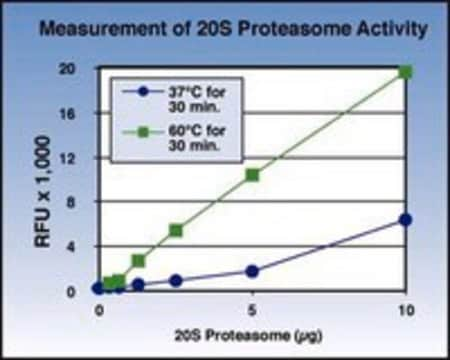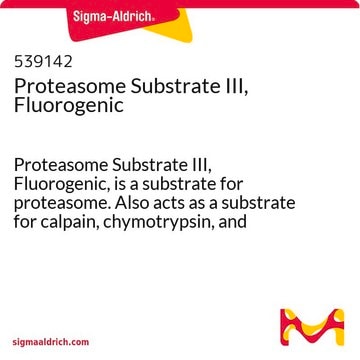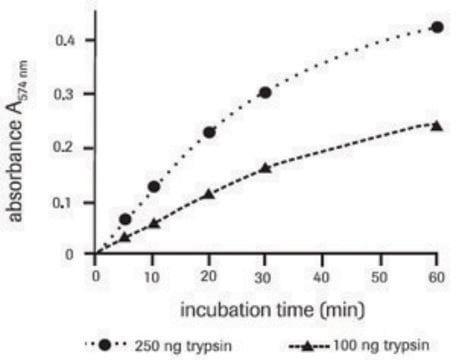MAK172
Proteasome 20S Activity Assay Kit
sufficient for 100 fluorometric tests
Sinonimo/i:
20S Proteasome Detection Kit
Autenticatiper visualizzare i prezzi riservati alla tua organizzazione & contrattuali
About This Item
Prodotti consigliati
impiego
sufficient for 100 fluorometric tests
Metodo di rivelazione
fluorometric
Malattie correlate
endocrinological disorders, diabetes; neurological disorders; cancer
Temperatura di conservazione
−20°C
Categorie correlate
Descrizione generale
Protein degradation occurs most commonly through two major mechanisms, lysosomal degradation and proteasome mediated degradation. Lysosomal degradation occurs through proteolytic enzyme activity and is fairly non-specific. Proteasomal degradation is targeted for a specific protein through the ubiquitination of the target protein. The target protein is typically poly-ubiquitinated and activates the 26S proteasome toward proteolysis. The proteasome 26S is the most common form of the proteasome and is an ATP-dependent proteolytic complex, which contains one 20S (700-kDa) core particle structure and two 19S (700-kDa) regulatory caps.
The proteasome is responsible for the recycling of proteins and maintenance of the balance of protein synthesis and degradation. The proteasome is involved with apoptosis, DNA repair, endocytosis, and cell cycle and has been implicated in disease states such as certain types of cancer, diabetes mellitus, and Alzheimer′s disease among others making it the target for drug discovery investigations.
The proteasome is responsible for the recycling of proteins and maintenance of the balance of protein synthesis and degradation. The proteasome is involved with apoptosis, DNA repair, endocytosis, and cell cycle and has been implicated in disease states such as certain types of cancer, diabetes mellitus, and Alzheimer′s disease among others making it the target for drug discovery investigations.
Caratteristiche e vantaggi
Compatible with high-throughput handling systems.
Compatibilità
Suitable for measuring the chymotrypsin-like protease activity associated with the proteasome complex either in cultured cells or cell lysates.
Principio
The fluorometric proteasome 20S assay kit is a homogeneous fluorescent assay that measures the chymotrypsin-like protease activity associated with the proteasome complex in cultured cells. This kit uses LLVY-R110 as a fluorogenic indicator for proteasome activities. Cleavage of LLVY-R110 by proteasome generates strongly green fluorescent R110 that is monitored fluorimetrically at 520-530 nm with excitation at 480-500 nm. The assay is robust, and can be readily adapted for high-throughput assays to evaluate the proteasome activities or screen the inhibitors in cultured cells or in solution. The assay can be performed in a convenient 96-well and 384-well fluorescence microtiter-plate format.
Codice della classe di stoccaggio
10 - Combustible liquids
Classe di pericolosità dell'acqua (WGK)
WGK 3
Certificati d'analisi (COA)
Cerca il Certificati d'analisi (COA) digitando il numero di lotto/batch corrispondente. I numeri di lotto o di batch sono stampati sull'etichetta dei prodotti dopo la parola ‘Lotto’ o ‘Batch’.
Possiedi già questo prodotto?
I documenti relativi ai prodotti acquistati recentemente sono disponibili nell’Archivio dei documenti.
I clienti hanno visto anche
Javier Quero et al.
Antioxidants (Basel, Switzerland), 10(2) (2021-02-11)
The application of plant extracts for therapeutic purposes has been used in traditional medicine because plants contain bioactive compounds with beneficial properties for health. Currently, the use of these compounds that are rich in polyphenols for the treatment and prevention
The Cell: A Molecular Approach (2000)
The proteasome: Overview of structure and functions
Tanaka K
Proceedings of the Japan Academy. Series B, Physical and Biological Sciences, 85(1), 12-36 (2009)
Inés Mármol et al.
Inorganic chemistry, 59(23), 17732-17745 (2020-11-19)
A series of gold(I) and silver(I) derivatives with N- or S-donor ligands derived from 2-anilinopyridine has been synthesized and characterized. The mononuclear structure of [Au(L1)(PPh3)](TfO) (1a) and [Au(L2)(PPh3)](TfO) (1b) was confirmed by X-ray diffraction studies, as well as the dinuclear
Apoorva Tangri et al.
Molecular cancer research : MCR, 19(7), 1168-1181 (2021-03-24)
High-grade serous ovarian cancer (HGSOC) is characterized by chromosomal instability, DNA damage, oxidative stress, and high metabolic demand that exacerbate misfolded, unfolded, and damaged protein burden resulting in increased proteotoxicity. However, the underlying mechanisms that maintain protein homeostasis to promote
Il team dei nostri ricercatori vanta grande esperienza in tutte le aree della ricerca quali Life Science, scienza dei materiali, sintesi chimica, cromatografia, discipline analitiche, ecc..
Contatta l'Assistenza Tecnica.











